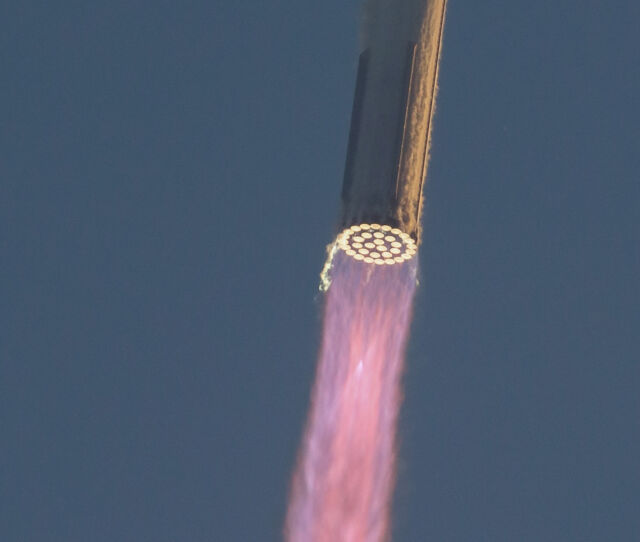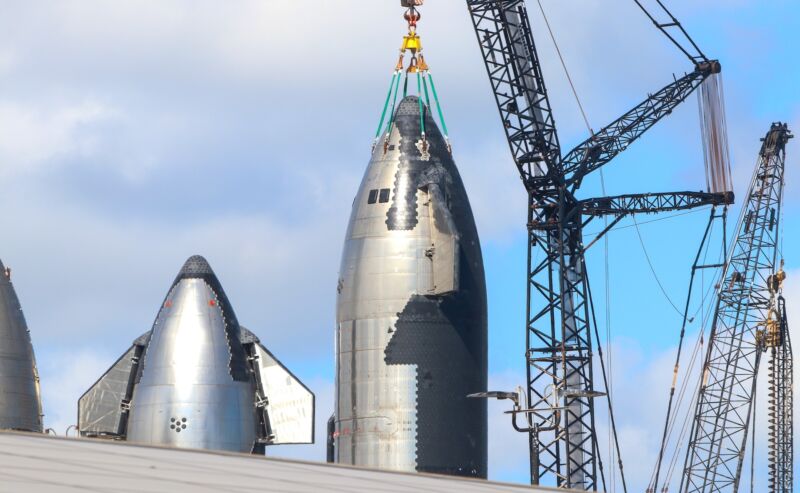SpaceX and NASA could take a tentative step toward orbital refueling on the next test flight of Starship, but the US space agency says officials haven't made a final decision on when to begin demonstrating cryogenic propellant transfer capabilities that are necessary to return astronauts to the Moon.
NASA is keen on demonstrating orbital refueling technology, an advancement that could lead to propellant depots in space to feed rockets heading to distant destinations beyond Earth orbit. In 2020, NASA announced agreements with four companies—Lockheed Martin, United Launch Alliance, SpaceX, and a Florida-based startup named Eta Space—to prove capabilities in the area of refueling and propellant depots using cryogenic propellants.
These cryogenic fluids—liquid hydrogen, methane, and liquid oxygen—must be kept at temperatures of several hundred degrees below zero, or they turn into a gas and boil off. Russian supply freighters regularly refuel the International Space Station with hydrazine and nitrogen tetroxide, room-temperature rocket propellants that can be stored for years in orbit, but rockets using more efficient super-cold propellants have typically needed to complete their missions within hours.
NASA and industry engineers want to extend this lifetime to days, weeks, or months, but this requires new technologies to maintain the propellants at cryogenic temperature and, in some cases like Starship, to transfer the propellants from one vehicle to another.
NASA and several companies are funding efforts in this area, called cryogenic fluid management. NASA's agreements from 2020 committed more than $250 million in government funding for cryogenic fluid management tests in space. These funding agreements announced in October 2020, called "Tipping Point" awards, require substantial private funding from the companies participating in the demonstrations.
According to John Dankanich, who leads NASA's efforts in developing new capabilities for in-space transportation, there are "major technical obstacles" for cryogenic fluid management. The real challenge, he said, will be in validating things like automated couplers, flow meters, and advanced insulation all work together in microgravity. These, along with other technologies, are "highly interdependent" on one another to make cryogenic refueling a reality, he said.
Individual technologies necessary for in-orbit cryogenic refueling are at a stage of development where they are "ready now to go into flight systems," Dankanich said, either with a demonstration in space or on an operational spacecraft.
First, small steps
By the fourth anniversary of those awards, only SpaceX appears to have a chance to complete the tasks outlined in its "Tipping Point" award, valued at $53 million.
This test would involve transferring super-cold propellant from one tank to another inside a Starship spacecraft. It's a precursor to future, more complex demonstrations involving two giant Starships docked together in Earth orbit. Then SpaceX will be ready to send a Starship toward the Moon for a test landing without astronauts onboard. Once that is successful, NASA will clear Starship for a crew landing on the agency's Artemis III mission, marking the astronauts' return to the lunar surface for the first time since 1972.
That's easier said than done; all worthy projects require a first step. That could happen as soon as the next full-scale test flight of SpaceX's gigantic Super Heavy booster and Starship rocket, a stainless steel launcher that stands nearly 400 feet (121 meters) tall. SpaceX has flown the rocket twice, most recently on November 18, when the Starship upper stage reached space for the first time before self-destructing just short of orbital velocity. This test flight was largely successful, achieving several key milestones such as stage separation and demonstrating improved reliability of the rocket's methane-fueled Raptor engines.
SpaceX has a $2.9 billion contract with NASA to provide a commercial Human Landing System (HLS) derived from Starship for the Artemis III mission, the first human landing mission planned during NASA's Artemis program. The readiness of the Starship landing craft and new commercial spacesuits are widely seen as drivers of the schedule for Artemis III, which is at risk of a delay from late 2025.
Lakiesha Hawkins, deputy associate administrator for NASA's Moon to Mars program office, discussed the Artemis schedule Monday with a committee from the National Academies charged with reviewing the agency's workforce, infrastructure, and technology programs.
Hawkins did not verbally address SpaceX's plans for the next Starship test flight, but one of her slides noted SpaceX is "moving quickly" toward the third Super Heavy/Starship launch, and that this flight "will include a propellant transfer demonstration."
However, Jimi Russell, a NASA spokesperson, suggested to Ars this is still only a possibility. When it does happen, the tank-to-tank propellant transfer within Starship will demonstrate moving 10 metric tons of liquid oxygen, according to the 2020 Tipping Point award terms. SpaceX is collaborating with NASA's Glenn Research Center and Marshall Space Flight Center on the demonstration.
"NASA and SpaceX are reviewing options for the demonstration to take place during an integrated flight test of Starship and the Super Heavy rocket," Russell said in a statement. "However, no final decisions on timing have been made."
Elon Musk, the company's founder and CEO, said on November 19 that hardware for the next Super Heavy/Starship test should be ready in three to four weeks. That projection seems dubious because SpaceX hasn't moved any pieces of the rocket to the launch pad for pre-flight testing, but a test flight early next year appears realistic.
Other factors that could play into the Starship launch schedule include tune-ups or fixes to resolve problems that occurred on the November 18 test flight and receiving a new launch license from the Federal Aviation Administration.
When SpaceX tries transferring 10 metric tons of propellant from tank to tank inside Starship, it will be at a scale never before attempted in space. But it's a small fraction of the amount of fuel and oxidizer needed to fill a Starship spacecraft in orbit. The ship's total propellant capacity is some 1,200 metric tons. After the tank-to-tank demonstration, SpaceX will attempt a ship-to-ship propellant transfer between two Starships linked together in Earth orbit.
"That’s really when we start maturing the systems, and when it really gets exciting for HLS, because those are the building blocks that we need and, frankly, it’s never been done successfully in orbit," said Lisa Watson-Morgan, NASA's HLS program manager, in an interview with Ars last month.
This discussion of propellant transfer leaves out critical work on Starship's life support system needed to accommodate crews on the lunar surface. SpaceX also needs to move forward with more Raptor engine testing, but the company recently completed a ground test to confirm it can reignite a Raptor engine in the extreme cold conditions resulting from extended time in space. SpaceX has also completed Raptor test-firings at different throttle settings to simulate how the engines must perform during a descent burn to reach the lunar surface.
Others in the running
The other companies working with NASA on cryogenic fluid management are still at least a couple of years away from any meaningful flight demonstrations.
Lockheed Martin's demo, expected to use liquid hydrogen, is scheduled for 2025 and will test 15 key cryo fluid management technologies. Eta Space is developing a small-scale fuel depot to demonstrate long-duration cryogenic storage of liquid oxygen for nine months. This mission, known as LOXSAT, is scheduled to launch with Rocket Lab in 2025, according to Dankanich.
Liquid hydrogen is the smallest molecule and needs to be stored at colder temperatures than methane or liquid oxygen. It is the most efficient rocket fuel in common use, but is prone to leaks.
United Launch Alliance is working on a liquid hydrogen/liquid oxygen "smart propulsion cryogenic system" on a Vulcan Centaur upper stage, testing precise tank pressure control, tank-to-tank transfer, and multi-week propellant storage, according to NASA. Dankanich said Monday ULA's flight demonstration is scheduled for 2026.

Thirty-three engines fired to power the Super Heavy booster and Starship rocket into the sky on
SpaceX's November 18 test flight.
Stephen Clark / Ars Technica
Like Starship, Blue Origin's human-rated lunar lander for Artemis will rely on orbital refueling but with liquid hydrogen. Blue Origin's approach to cryogenic fluid management involves actively controlling the temperature of liquid hydrogen using cryocoolers, while SpaceX is using passive thermal control on Starship.
Dankanich said Blue Origin plans "multiple interim demonstrations" with its cryogenic systems before its lander is certified to carry astronauts to the Moon's surface, but he didn't offer a schedule for those flight tests leading up to Blue Origin's first human landing mission, slated for no sooner than 2029.
Aside from technical hurdles, Dankanich said there's another potential barrier to widespread advancements in cryogenic refueling and propellant depots. For most of the tech demos, NASA is partnering with companies on a cost-sharing basis, reducing the cost to taxpayers. NASA would like to use data from the demonstrations to provide "ground truth" for models to predict the behavior of cryogenic fluids in space. Because NASA is a government agency, these models would be available to a broad cross-section of researchers and engineers.
Under the terms of these public-private partnerships, industry retains ownership, and these companies may consider details about their technology proprietary, limiting NASA's ability to share lessons learned with academic institutions or other outside groups.
“In some cases, we can't force them to even instrument the systems in the way that we need them instrumented in order to get the data that we would need to validate," Dankanich said. "If they're willing to provide the telemetry that we need, then we may, on the NASA side, be able to get some of that information. But we can't disclose the design details or the specifics to the community, which is necessary for model validation.
"Data right restrictions are a big challenge with the way that we're procuring all of our cryogenic fluid management systems," Dankanich said. "At the same time, the outlook is pretty good, right? We do have the SpaceX large-scale cryo settling propellant transfer planned for next year."



3175x175(CURRENT).thumb.jpg.b05acc060982b36f5891ba728e6d953c.jpg)


Recommended Comments
There are no comments to display.
Join the conversation
You can post now and register later. If you have an account, sign in now to post with your account.
Note: Your post will require moderator approval before it will be visible.